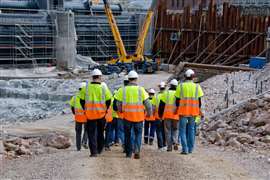Increased construction activity expected after US Fed cuts rates
20 September 2024
After more than four long years of a rising or stagnant Federal Funds Rate (FFR) in the US, the country’s Federal Reserve – its central banking system – announced it cut the rate by 50 basis points on 18 September, and industry experts believe it will lead to an increase in construction activity.
 US Federal Reserve Board Chair Jerome Powell holds a press conference following a two-day meeting of the Federal Open Market Committee on interest rate policy in Washington D.C., US, on 18 September. (Image: Reuters/Tom Brenner)
US Federal Reserve Board Chair Jerome Powell holds a press conference following a two-day meeting of the Federal Open Market Committee on interest rate policy in Washington D.C., US, on 18 September. (Image: Reuters/Tom Brenner)
The new FFR – the interest rate at which US depositories can borrow from other depositories – was lowered to a range of 4.75-5% from a range of 5.25-5.5% (where it stood since July 2023).
The US stock market responded by jumping higher on the news, and most industries celebrated the announcement.
But what will it mean for construction?
Rate cuts will boost commercial construction activity, eventually
 Workers climb infrastructure on a construction site. (Image: Adobe Stock)
Workers climb infrastructure on a construction site. (Image: Adobe Stock)
Altus Group – a Canada-based provider of asset and fund intelligence for commercial real estate – acknowledged that the news is sure to drive additional borrowing.
But the firm cautioned against over-optimism.
“It’s important to note that the reduction in financing costs is unlikely to be felt evenly and widely across the economy. Rate cuts, at least at the beginning of an easing cycle, bear more of a psychological impact than a tangible one across the US commercial real estate market,” said Altus Group.
Omar Eltorai, research director at Altus Group, pointed out there is an indirect, not a direct, correlation between the FFR and consumer borrowing.
“The Fed Funds Rate is not the rate at which businesses, investors, or consumers borrow or access financing, so these effects will take time to flow through,” explained Eltorai. “However, the signal sent by the first cut may be beneficial in the near-term, as this shift in policy stance can be factored into business projections, expectations, and valuations.
“Much of this is already visible in the stock market where rate-sensitive sectors and companies have generally benefited from the anticipated start to the cuts already.”
But if the Federal Reserve stays on its present path of measured cuts to the FFR – Altus Group used the expected cut of 25 basis points at each of the remaining two policy meetings in 2024 – that “we may see more movement across the US commercial real estate market at the start of 2025.”
While there’s still some key dates and metrics to reach, all things considered the positivity was palpable in the commercial sector come the morning of 19 September.
“Today’s decision should translate to an uptick in sentiment across investors waiting on the sidelines, who may be readying themselves to re-enter the fold,” said Altus Group.
Flagging housing starts could tick up on Federal Reserve’s cut
 Construction workers walk towards a site. (Image: Adobe Stock)
Construction workers walk towards a site. (Image: Adobe Stock)
Across the nation, there were few positive statistics for the US homebuilding industry, particularly for single family residence. The US Department of Commerce Census Bureau reported that single-family housing starts dropped more than 6.8% from June to July and 16% year-on-year.
But, while the commercial building sector will likely need to take time to reap the benefits of reduced FFR borrowing, the single-family residential market may see immediate benefits.
Aldrich Advisors – a US-based accounting, audit, taxes, and management firm – noted the FFR reduction’s indirect effect on US mortgage rates (they are expected to go down) could lead to more construction starts.
Joe Schneid, a CPA and CCIFP with Alrich CPAs + Advisors, said, “Mortgage interest rate hikes over the last two years have significantly slowed the sales of new and existing homes… A reduction in mortgage rates can lead to housing starts on a faster timeline.”
He noted that major commercial projects are up against the clock more than residential builds.
“It takes a long time to go from planning and design, through permitting to bidding, financing, and starting a project, so changes in rates in the short term are not expected,” said Schneid.
Instead, he projected residential building will be first to reap the benefits.
“As rates stabilize, more borrowers will enter the market for two reasons,” Schneid said. “First because of pent-up demand, and second because rates in the 5% or 6% range are close to the 30-year average. Homebuyers may find a new normal at higher rates and may not see sub-4% again.”
Construction firms should expect renewed availability of bank financing, a steadying of production wage and material costs and more options when it comes to borrowing, Schneid said.
And even though single-family homebuilding might get the biggest boost on the news, Schneid acknowledged, assuming the Fed can remain on its rate-cut schedule, that the construction industry as a whole is set to benefit.
“A downward change in rates should free up bank financing on market-rate housing and commercial building projects,” said Schneid.
On top of it, August’s housing construction start figures were already trending the right way: released on 18 September (the same day as the rate-cut announcement), it shows construction starts on new residential building rose 9.6% over July and was up almost 4% year-on-year.
CONECTAR-SE COM A EQUIPE





